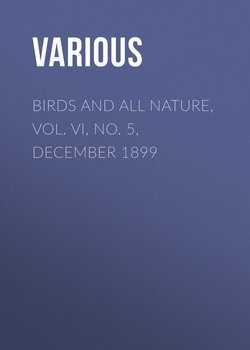Читать книгу Birds and All Nature, Vol. VI, No. 5, December 1899 - Various - Страница 5
OUR NATIVE WOODS
ОглавлениеREST H. METCALF
HOW many different varieties of wood are there in your own town? If you never have considered this question you will be surprised at the variety, and, I am sure, will enjoy making a collection for yourself. A pretty cabinet size is two inches in length and the same in diameter. This size is very convenient, unless you have an abundance of room, and will show fibre, grain, and color quite distinctly. If you will plane off two sides of the block you will see the grain plainly, and, if possible to polish one side, you will see what a beautiful finish some of our own woods will take.
All that is necessary in obtaining your collection is a small saw, but a congenial companion will greatly add to your pleasure. Saw your specimen considerably longer than you call for after it is prepared, for most of the varieties will check in drying; then let it thoroughly dry before preparing for your collection. The fruit trees around your home may first take your attention. You will be interested in noting the differences in the grain of the apple, apricot, barberry, cherry, pear, peach, plum, and quince; and while you are becoming interested in the fruit trees, notice the variety of birds that visit the different trees, for you will find each bird has its favorite fruit and favorite nesting-place. The mountain ash will perhaps feed as many birds in the fall and winter as any tree, and is a pretty tree for the lawn, holding its place with the maples, the ever graceful elm, admired by all, except the man who is trying to split it into fire-wood, and a favorite with the Baltimore oriole. If you wonder why the horse chestnut was so named, just examine the scars after the leaves fall and you will think it rightly named. Who has not tried carrying a horse chestnut in his pocket to prevent rheumatism? The weeping birch, as well as the weeping maple, are much admired for shade and ornamentation, but are not very common. We were told recently that the Lombardy poplar was coming back as a tree for our lawns, but many prefer the balm-of-gilead, so popular for its medicinal qualities. In the United States there are thirty-six varieties of the oak; you will find several in your own town and I trust will add a collection of acorns to your cabinet, and friends from the South and West will help make your collection a complete one. Then you will become interested in the cone-bearing trees and a variety of cones will also be added to your evergrowing collection, you will enjoy gathering some green cones and listening to the report as the seed chambers open, and if you gather a small vial of the common pine and hemlock seeds you will puzzle many a friend. One person remarked, when shown a vial of hemlock seed, "O yes, I have seen something like that, that came from Palestine, but I have forgotten the name." Some of the fir trees are pitted with holes where the woodpeckers insert grub-bearing acorns, leaving the grub to fatten, and in the fullness of time devouring it. Then the trees bearing edible nuts will call for their share of attention. The chestnut is familiar to all, as well as the butternut and hazelnut, but I knew one collector who called an ash tree butternut. There are twelve varieties of ash in our country, a wood that is coming more and more into prominence, and deservedly so; its toughness is proverbial, and it has long been utilized by carriage-makers for certain parts of wheels. A fine, handsome wood, combining in itself the qualities of oak and pine.
